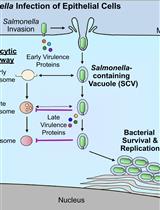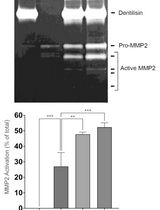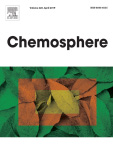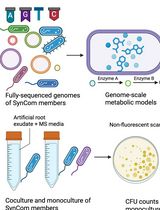- EN - English
- CN - 中文
A Microbial Bioassay for Direct Contact Assessment of Soil Toxicity Based on Oxygen Consumption of Sulfur Oxidizing Bacteria
基于硫氧化细菌耗氧的直接接触土壤毒性的微生物检定方法
发布: 2020年01月05日第10卷第1期 DOI: 10.21769/BioProtoc.3470 浏览次数: 4369
评审: Alba BlesaFrancesco Dal GrandeJan-Ulrik Dahl

相关实验方案

细菌病原体介导的宿主向溶酶体运输的抑制:基于荧光显微镜的DQ-Red BSA分析
Mădălina Mocăniță [...] Vanessa M. D'Costa
2024年03月05日 2874 阅读

通过制备连续聚丙烯酰胺凝胶电泳和凝胶酶谱分析法纯化来自梭状龋齿螺旋体的天然Dentilisin复合物及其功能分析
Pachiyappan Kamarajan [...] Yvonne L. Kapila
2024年04月05日 2039 阅读
Abstract
A new direct contact assessment of soil toxicity using sulfur oxidizing bacteria (SOB) is proposed for analyzing the toxicity of soils. The proposed method is based on the ability of SOB to oxidize elemental sulfur to sulfuric acid in the presence of oxygen. Since sulfate ions are produced from sulfur by SOB oxidation activity, changes in electrical conductivity (EC) serve as a proxy to assess toxicity in water. However, in soil medium, EC values are not reliable due to the adsorption of SO42- ions by soils. Here, we suggest a new parameter which measures oxygen consumption by SOB for 6 hours to assess soil toxicity by using a lubricated glass syringe method. The proposed method is rapid, simple, cost- effective as well as sensitive and capable of assessing direct contact soil toxicity.
Keywords: Toxicity assessment (毒性测定)Background
Currently, the most prevalent technologies used in detecting toxic chemicals are gas chromatography (GC), high liquid chromatography (HPLC), and atomic absorption spectroscopy (AAS) that provide accurate measurements by applying different detection principles. However, these well-established methods require both skilled personnel and expensive equipment and cannot practically measure all the toxic chemicals in soil (Brouwer, 1991; Eom et al., 2019a). In contrast, bioassays have been one of the most useful technologies for the detection of environmental toxicity. Bioassays depend on changes in the physiological responses of living organisms to toxic chemicals. Ecotoxicological tests (ET) more precisely identify the cumulative and synergistic effects of toxic contaminants even if they fail to clearly identify all toxic chemicals (Sisinno et al., 2007).
Several toxicity bioassays are based on measurements of growth inhibition, oxygen uptake, colony formation, or luminescence for screening toxicants in industrial effluents, sediments, and soils (Selivanovskaya et al., 2010). To date, few studies exist for direct contact assessment of toxicants in soil medium. To evaluate soil toxicity, both liquid phase (soil elutriates) and solid phase bioassays (direct contact tests) are commonly used (Hubálek et al., 2007). In liquid-phase bioassays, test organisms are exposed to the elutriate of toxicants previously in solid-phase after dissolution in water or organic solvents (Gälli et al., 1994; Tarradellas et al., 1996; Maxam et al., 2000). This approach provides limited information on solids-associated toxicity because, using aqueous elutriates, the elutriating process cannot accommodate the complexity of the solid-phase of soil (Ronnpagel et al., 1995; Selivanovskaya et al., 2010). Moreover, partial dissolution of toxicants in soil or synergistic effects between toxicants and an extractant can possibly underestimate or overestimate the toxicity of contaminants in soil (Ronnpagel et al., 1995; Tarradellas et al., 1996; Selivanovskaya et al., 2010).
On the other hand, direct contact toxicity tests can measure the total toxic response of diverse types of contaminants in a soil sample. A direct contact bioassay could enables the determination of actual toxicity of contaminants in a highly dynamic and complex system (soil or sediments) much better than aqueous elutriates of solids (Ronnpagel et al., 1995).
Recently, SOB bioassays have been successfully employed in water, wastewater, soil toxicity detection and assessment (Oh et al., 2011; Van Ginkel et al., 2011; Gurung and Oh, 2013; Ahmed et al., 2019, Eom et al., 2019a). Most toxicity assessment studies have been carried out in aqueous phase while few studies have investigated soil toxicity by SOB (Gurung and Oh, 2013; Ahmed et al., 2019, Eom et al., 2019b). SOB are chemoautotrophic bacteria which grow as a biofilm on the surface of elemental sulfur particles. They have the ability to oxidize sulfur (electron donor) to sulfuric acid in the presence of oxygen (electron acceptor) as shown in Eq. 1 (Oh et al., 2011; Hassan et al., 2013).

During oxidation, SOB consumes molecular oxygen and produce sulfate (SO42-) and two protons (H+). Production of H+ acidifies the medium, thereby reducing pH and increasing EC (Oh et al., 2011). Upon introduction of a toxic contaminant into the SOB reactors in aqueous media, SOB growth and oxidation becomes inhibited resulting in lower increase of EC (Hassan et al., 2013). However, the heterogeneous nature of soils and their ability to adsorb sulfate ions prevents EC in soils from increasing, making the use of EC an unreliable indicator of soil toxicity assessment using SOB. Our proposed method introduces the direct contact assessment of soil toxicity using oxygen consumption by SOB during a defined period of incubation as a new parameter.
Materials and Reagents
- 0.5 and 2.0 mm testing sieve (Chunggye Sanggong sa, Seoul, Korea)
- Sulfur granules (MIDAS-SG, Miwon Commercial Co. Ltd, Korea)
- 10 ml glass syringe (Truth, Top Syringe Mfg Co (P) Ltd, India)
- 12 L plastic container (Influent and effluent tanks)
- 1.3 L fabricated acrylic container (0.13 m x 0.13 m x 0.15 m)
- 6 DRAM CLR round glass vials 20-400TD (KD brand, catalog number: 324020-2385)
- Stainless steel wire test tube rack (model: TRS-2350, catalog number: ROI-11-590)
- 20 MMX.100 PTFE Teflon rubber stoppers (857518197L-610050-20, USA)
- Open top screwcaps (Daihan Scientific, WH.W240506 cap, screw, 8-425)
- Plastic weighing dish (Lab Korea, B17-132-034-1815-002)
- CuSO4·5H2O (Sigma-Aldrich, catalog number: 209198-100G)
- (NH4)6Mo7O24·4H2O (Daejung, catalog number: 1073-4475)
- FeSO4·7H2O (Sigma-Aldrich, catalog number: 7782-63-0)
- NH4Cl (Junsei, catalog number: 18075-0350)
- KCl (Daejung, catalog number: 6566-4400)
- NaH2PO4 (Daejung, catalog number: 7615-4400)
- Na2HPO4 (Daejung, catalog number: 7613-4400)
- NaHCO3 (Daejung, catalog number: 7566-4400)
- Yeast extract (Bacto, catalog number: 212750)
- CaCl2·2H2O (Sigma-Aldrich, catalog number: C3881-500G)
- MnCl2·4H2O (Daejung, catalog number: 5526-4400)
- ZnSO4·7H2O (Daejung, catalog number: 8607-4400)
- K2Cr2O7 (Daejung, catalog number: 6572-4400)
- CoCl2·6H2O
- Dish washing detergent
- Synthetic medium (see Recipes)
Equipment
- Adjustable volume micropipettes, 0-200 μl and 100-1,000 μl (Biorad Industries, USA)
- Refrigerated low temperature BOD incubator (JSI Industries, Korea JSBI-150C)
- Shaking water bath (Lab Companion BS-31 (55 L), model: SKU: V018. AAH44311K)
- Digital precise water bath (Daihan Scientific, Korea WB-11)
- Electrical conductivity meter (Lutron, model: YK-2005CD)
- Digital electronic scale (Scharwz, model: SCH1812S)
- Air pump (PhilGreen, model: BT-6500)
- 20-30 cm flexible air sparger for the sulfur master culture reactor (SMCR)
- Peristatic pump (Techno, Lab system, model: PP-150D; POOLIM. CO, Korea)
- Cisa BA 200N electromagnetic digital sieve shaker (Cisa Cedaceria Industrial S.L, Spain)
- MasterFlex peristaltic tubing
Software
- Sigmaplot (Systat software Inc, https://systatsoftware.com/products/sigmaplot/)
- Toxicalc (Tidepool Scientific Software, https://tidepool-scientific.com/ToxCalc/ToxCalc.html)
Procedure
文章信息
版权信息
© 2020 The Authors; exclusive licensee Bio-protocol LLC.
如何引用
Ashun, E., Toor, U. A., Eom, H. and Oh, S. (2020). A Microbial Bioassay for Direct Contact Assessment of Soil Toxicity Based on Oxygen Consumption of Sulfur Oxidizing Bacteria. Bio-protocol 10(1): e3470. DOI: 10.21769/BioProtoc.3470.
分类
微生物学 > 微生物遗传学 > 基因图谱和克隆
微生物学 > 微生物生物膜 > 生物膜培养
微生物学 > 微生物-宿主相互作用 > 细菌
您对这篇实验方法有问题吗?
在此处发布您的问题,我们将邀请本文作者来回答。同时,我们会将您的问题发布到Bio-protocol Exchange,以便寻求社区成员的帮助。
Share
Bluesky
X
Copy link











